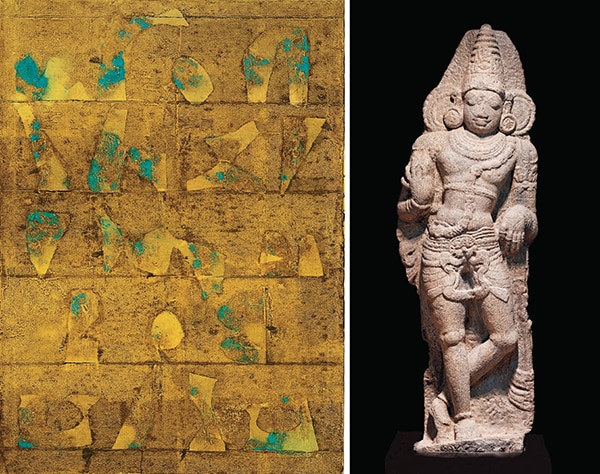
If you owned a Modigliani, you'd rather sell it in New York: William Robinson
William Robinson, international head of world art at Christie's auction house, says Indian art has a strong market but it'll take time for the country to become a preferred place to sell international artworks
Q. Christie’s has been holding auctions in India for three years now. What’s your assessment of the Indian art market in this period?
The market has been consistently strong. The first sale showed great strength throughout the category of modern paintings, and it continued with the second sale. The sale percentages were similar in terms of lots sold, and even though the total was a little less in 2014, it was the highest for any sale [in India] that year. The year 2015 saw some strong moments for Indian art: We set a new world auction record for MF Husain in June in London (Untitled, 1956, sold for $1.7 million), which was followed by FN Souza (Birth, 1955, sold for $4.085 million) in September in New York; it was then a new world record for the category, and still a record auction price for the artist. The third India sale set the highest total for any auction in India at Rs 97.7 crore and the highest price for Indian art, with VS Gaitonde’s untitled masterwork going for Rs 29.3 crore. The latter also overtook Souza to command the highest price for any modern Indian work of art. For the first time, we offered a dedicated section to classical Indian art and the response from our clients and collectors was very positive, with only one lot going unsold.
Q. Where does that place India on the world map? What does India have to do to catch up with global art hubs like London and New York?
The market in India at the moment is a market for Indian art. It has already more than caught up with the London and New York markets in that regard. For Indian art, the Mumbai sales are our strongest. This is what we save up for. There is a very international buying audience, especially with the modern and contemporary works of art. In all our three annual sales, the buyers of the top lot have been from abroad.
However, we don’t sell [Amedeo] Modiglianis in India and it will be a long time till India becomes a preferred place for selling [international] works like his. If there was a Modigliani that had an Indian provenance and appeared with a family in India, there would be a real interest in it because it adds to the history. But more of the highest prices for modern and contemporary pieces have been achieved in a place like, say, New York. So, if you owned a Modigliani, you’d rather sell it there.
Q. Christie’s entered both India and China in 2013. How would you compare the two markets?
It’s difficult to compare, partly because there are very different regulatory provisions. In China, we can’t sell anything that is older than 1949. Here, we can sell but there are great restrictions on various import-export categories. What we are trying to do separately is to develop markets that are appropriate for the clients we have in India and China, taking advantage of the extra interest garnered for having a local sale.

Q. Despite an economic slowdown, there is a steep rise in prices for artworks. In your first auction in India, Gaitonde sold for Rs 23 crore, a record that was beaten by another Gaitonde selling for over Rs 29 crore last December. Recently, in New York, Modigliani’s Reclining Nude went for $170.4 million, the second-most expensive piece of artwork to be auctioned. How is the art market continuing to beat economic doldrums year after year?
First, good art is a scarce commodity. So when you get auctions like these, people want to buy. The other thing is that while some markets haven’t performed well, it is also true that people who have money have a huge amount of disposable income. Art has been seen as a good place for putting your money. That has been a factor why Christie’s sales have performed extremely well over the last six to seven years.
Q. Christie’s started online auctions in 2012. How is that helping the growth of art appreciation and the market?
These things happen slowly. We recently had our first online miniature painting sale that performed very well. Each online sale brings new bidders. But this is part of a growing process. We intend to grow the online market in all areas of art. Currently, over 25 percent of our annual sales are online-only. Online is fantastic for broadening our reach and selling good art that Mr and Mrs Smith would want; we may not yet know the Smiths, and the internet is a great way of reaching them.
But for great works of art, like a Gaitonde, the live auction is a wonderful place to sell. There is something about the theatre of a live auction that encourages people, gives them a sense of excitement that you don’t get in an online sale. You still have very determined bidders at times and pieces making many multiples of the estimate, but it will be a long time before we put some major pieces of work online.
Q. What do you think are some of the richest forms of Indian art?
I was really impressed by “Sultans of Deccan India 1500-1700”, an exhibition that took place at the Metropolitan Museum of Art last year. I came to India three years ago and spent quite a bit of time in the Deccan, so there’s a personal echo there. Some exquisite works have emanated from places like Bidar, Gulbarga, Bijapur, Golconda and Ahmednagar.
Q. India also has a diverse heritage of folk art, like Madhubani, Gond, Patachitra, scrolls. How do you think global organisations like Christie’s can take it to the world?
There is an element where we are reactive and an element where we are proactive. For our sales, we will have to sell what our clients want. For local art, it’s more of what we will do in our involvement with museums. We are always looking for opportunities within the market for facilitation or links between people using our huge network.
(This story appears in the 30 November, -0001 issue of Forbes India. To visit our Archives, click here.)






